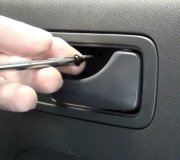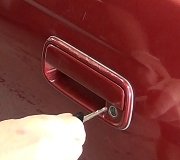The clue is "voltage drops off". Think of standing on a garden hose and squashing it 99 percent closed. With the nozzle turned off, you'll still have full pressure at the end of the hose. That's like the full voltage you're measuring. Open the nozzle and water can't get through fast enough so it just dribbles on your shoe. A pitted switch contact will do the same thing. Digital voltmeters draw almost no current so that restriction to current flow has no effect on the reading and you get the full 12 volts. Try and draw some current through that restriction by activating the window motor and that much current can't get through so the voltage, (electrical pressure) drops off.
For a passenger window current goes through both the passenger switch and the released part of the driver's switch so either one can have a bad contact. Also look for frayed or broken wires between the door hinges although the symptoms will usually be a little different at each switch. To add to the misery, GM used to build in relays into some of their switches. If you still have the more simple, reliable heavy switch contacts, you can usually clean them with some fine sandpaper.
A lot of newer vehicles need insane computers added to the circuit to make them work. In that case there may be relays under the dash that can be swapped as a test. Sometimes they're built into a sealed box to insure you have to buy an expensive replacement part. The clue there is there will only be three wires on any window switch, the feed and one for up and one for down. The older, more common sense circuits will have six wires for each switch. Each switch has two switches built in and each of those have two positions; pressed and released. Between the passenger switch and the driver's switch, there are four sets of contacts. All four should read continuity to ground when all of them are released. Depending on which switch is pressed, and whether it's up or down, one of those four contacts will have 12 volts applied and the other three will stay at ground.
What you need to do is have someone hold one of the switches in the dead direction, THEN do your voltage measurements. Use the body as ground for the meter, find the wire at the motor that's missing the 12 volts and follow it back through any switches to find where that 12 volts isn't making it through a switch contact or wire.
Sunday, June 17th, 2012 AT 7:48 PM


